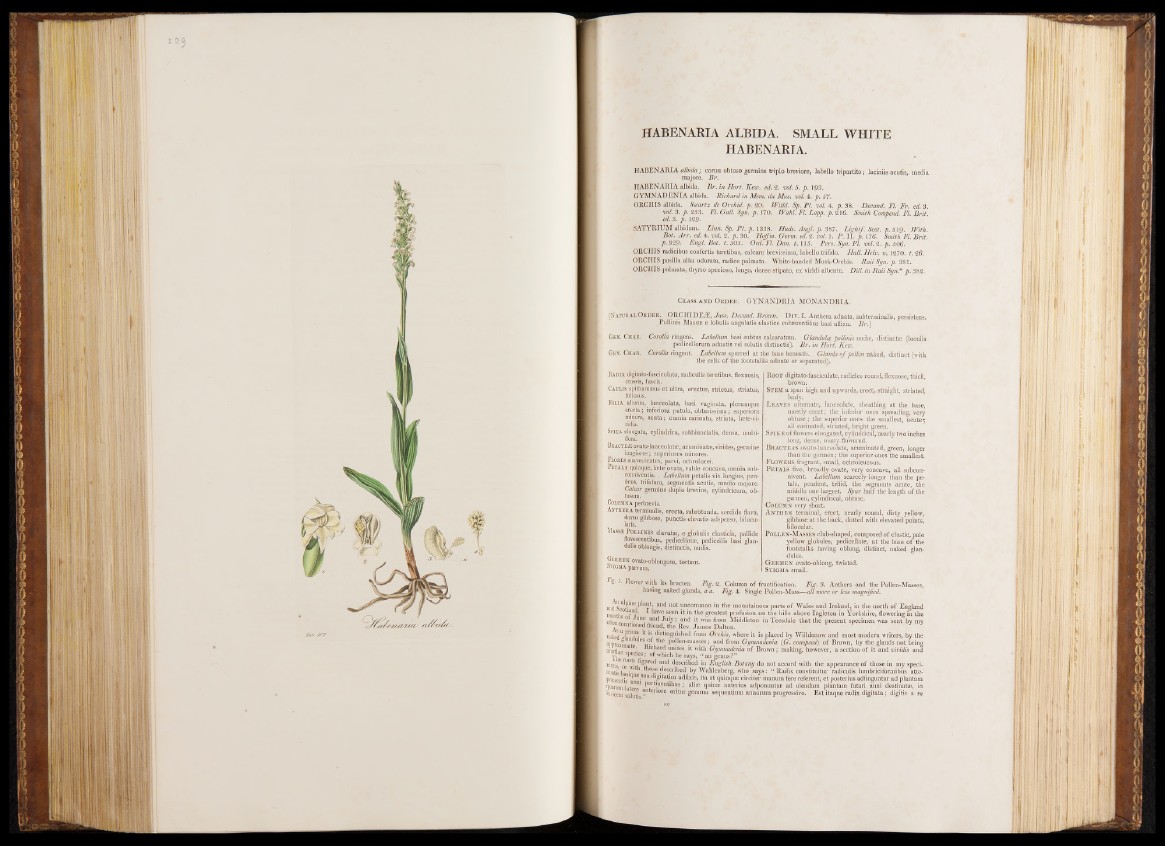
HABEN ARIA ALBIDA. SMALL WHITE
HABEN ARIA.
HABENARIA a lb id a ; cornu obtuso genuine triplo breviore, Iabello tripartita; laciniia-acutis, media
majore. B r .
HABENARIA albida. B r . in H o r t. K ew . ed. 2. vol. 5 . p . 193.
GYMNADENIA albida. R ic h a rd in Mem. d u M u s . vol. 4. p . 57.
ORCHIS albida. S w a r tz de Orchid, p . 20. W illd . Sp. PI. vol. 4. p . 38. D eca n d . FI. F r . ed. 3 .
vol. 3. p. 253. FI. Ga ll. S yn . p . 170. W a h l. FI. L a p p . p . 216. Sm ith Compend. FI. B r i t .
ed. 3. p . 129.
SATYRIUM albidum. L in n . S p. P i . p . 1338. H u d s . A n g l. p . 387. L ig h t f . Scot. p . 519. W ith .
B o t. A r r . ed. 4. vol. 2. p . SO. H o ffm . Ge rm . ed. 2. vol. 1. P . II. p . 176. Sm ith FI. B r i t ,
p . 929- E n g l. B o t. t . 505. Oed. FI. D a n . 1 . 115. _ P e ts . S y n . P I. vol. 2. p . 5 06.
ORCHIS radicibus confertis teretibus, calcare brevissimo, labello trifido. H a ll. H e lv . n . 1270. t. 26.
ORCHIS pusilla alba odorata, radice palmata. White-handed Musk-Orchis. R a il S yn . p . 381.
ORCHIS palmata, thyrso specioso, longo, dense stipato, ex viridi albente. D ill. in R a i i S y n * p . 382.
Class a n d Ord e r . GYNANDRIA MONANDRIA.
[Natural Order. ORCHIDEiE, Ju s s . De cand. B row n . D iv . I. Anthera adnata, subterminalis, persistens.
Pollinii Mass® e lobulis angulatis elastice coh®rentibus basi affixa. Br.~\
Gen. Char. Corolla ringens. Labellum basi subtus calcaratum. G la n d u la p o llinis nud®, distinct® (loculis
v peaicellorum adnatis vel solutis distinctis). B r . in H o r t. K a o .
Gen. Char. Corolla ringent. Labellum spurred a t the base beneath. Gla n d s o f pollen naked, distinct (with
the cells of the footstalks adnata or separated).
Radix digiteto-fasciculata, radiculis teretibus, flexuosis,
crassis, fuscis.
Caulis spithamæus et ultra, erectus, strictus, striatus,
foliosus.
Folia alterna, lanceolala, basi. vaginata, plenum que
erecta; inferiora pa tula, obtusissima; superiora
minora, acuta; omnia carinata, striata, l®te-vi-
ridia:,, j
Spica elongata, cylindrica, subbiuncialis, densa, multi-
flora; •’
BractE2E ovato-lanceolat®, acuminat®,virides, germine
longiores; superiores minores.
Flores suaveolentes, parvi, ochrolucei.
Petala quinque, l®te»ovata, valde concava, omnia sub-
conniventia. Lab ellum petalis vix lohgius, pendens,
trifidum, segmentis acutis, medio majore.
Calcar germine duplo brevius, cylindricum, ob-
tusum.
Columna perbrevis.
Anthera terminalis, erecta, subrotunda, sordide flava,
dorso gibboso, punctis elevatis adsperso, bilocu-
laris.
Massæ Pollinis clavat®, e globulis elasticis, pallide
flavescentibus, pedicellat®, pedicellis basi glan-
dulis oblongis, distinctis, nudis.
G Ermen ovato-oblonaum, tortum.
ûTIgma parvum.
% I. Flower with its Bractea. F ig . 2. Column of i
having naked glands, a a. F ig . 4. Singh
Root digitato-fasciculate, radicles round, flexuose, thick,
brown.
Stem a span high and upwards, erect, straight, striated,
leafy.
Leaves alternate, lanceolate, sheathing a t the base,
mostly erect; the inferior ones spreading, very
obtuse; the superior ones the smallest, acute^
all carinated, striated, bright green.
Sp ik e of flowers elongated, cylindrical, nearly two'inches
long, dense, many-flowered.
Bracteas ovato-lanceolate, acuminated, green, longer
than the germen; the superior ones the smallest.
F lowers fragrant, small, ochroleucous.
Petals five, broadly ovate, very concave, all subcon-
nivent. Lab ellum scarcely longer than the petals,
pendent, trifid, the segments acute, the
middle one largest. S p u r half the length o f the
germen, cylindrical, obtuse.
Column very short.
A n th e r terminal, erect, nearly round, dirty yellow,
gibbose at the back, dotted with elevated points,
bilocular.
Pollen-Masses club-shaped, composed of elastic, pale
yellow globules, pedicellate, at the base of the
footstalks having oblong, distinct, naked glandules.
Ge rm en ovato-oblong, twisted.
St igma small.
notification. F ig . 3. Anthers and the Pollen-Masses,
Pollen-Mass— a ll more o r less magnified.
and Srnt|ln an(^ not [in,common in the mountainous parts of Wales and Ireland, in the north o f England
months nf T * nave seen it in the greatest profusion on the hills above Ingleton in Yorkshire, flowering in the
oftpn Un? ra. July I and it was from Middleton in Teesdale that the present specimen was sent by my
OHen-mentioned friend, the Rev. James Dalton. ' *
naked vlnn11}18! ^ distinguished from Orchis, where it is placed by Willdenow and most modern writers, by the
aPProximnf U eSp -u j ; and from Gymnadenia (G . conopsed) of Brown, by the glands not being
anothpr . J ' Rlchai'd unites it with Gymnadenia of Biown; making, however, a section of it and v ir id is and
The r P fi ; °f Wh Ch he s.ays’ “ I I genus ?"
mens'6 o r anc* described in E n g lish B o ta n y do not accord with the appearance of those in my speci-
nuatisbasiau 1 described by Wahlenberg, who says: “ Radix constituitur radiculis lumbriciformibus atte-
prajsentis' ane'SUa &dfixis, ita ut quinque circiter manum fere referent, et posterius adfinguntur ad plantain
quanun latere1 P®r.t!nentl^>“s '■> quin® anterius adponuntur ad alendam plantam futuri anni destinat®, in
invicem soluti ante'll0re or*tur gemma sequentium annorum progressive. Est itaque radix digitata; digitis a se